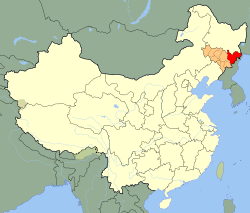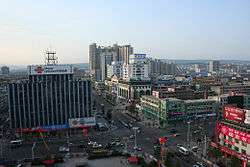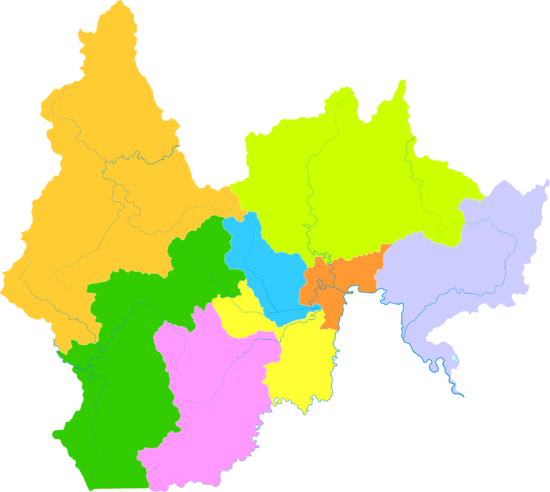Yanbian Korean Autonomous Prefecture
| Yanbian Prefecture 延边州 · 연변주 | |
|---|---|
| Autonomous prefecture | |
Yanbian Korean Autonomous Prefecture 연변 조선족 자치주延边朝鲜族自治州 | |
|
Yanji, the prefectural seat of Yanbian | |
 Yanbian (red) in Jilin (orange) and China | |
| Coordinates: 43°08′N 129°11′E / 43.133°N 129.183°ECoordinates: 43°08′N 129°11′E / 43.133°N 129.183°E | |
| Country | People's Republic of China |
| Province | Jilin |
| County-level divisions |
6 county-level cities 2 counties |
| Prefectural seat | Yanji |
| Government | |
| • Party Secretary | Zhang Anshun |
| Area | |
| • Total | 43,509 km2 (16,799 sq mi) |
| Population (2010) | |
| • Total | 2,271,600 |
| • Density | 52/km2 (140/sq mi) |
| • Ethnic composition | |
| Time zone | China Standard (UTC+8) |
| Area code(s) | 0433 |
| Licence plate prefixes | 吉H |
| Website | http://www.yanbian.gov.cn/ |
Yanbian (Chinese: 延边, Chinese Korean : 연변, South Korean transliteration: 옌볜) is an Autonomous Prefecture in northeastern Jilin Province, People's Republic of China, just north of the border with North Korea. Yanbian is bordered to the north by Heilongjiang, on the west by Baishan City and Jilin City, on the south by North Hamgyong Province of North Korea, and on the east by Primorsky Krai of Russia. Yanbian is designated as an autonomous prefecture due to the large number of ethnic Koreans living in the region. The prefectural capital is Yanji, and the total area is 42,700 square kilometres (16,500 sq mi).
The Prefecture has an important Balhae archaeological site: the Ancient Tombs at Longtou Mountain, which includes the Mausoleum of Princess Jeonghyo.
Administration
The prefecture is subdivided into eight county-level divisions: six county-level cities and two counties:
| Map | ||||||||||||
|---|---|---|---|---|---|---|---|---|---|---|---|---|
| Name | Chinese | Hanyu Pinyin | Chinese Korean transliteration | South Korean standard transliteration | Population (2003 est.) | Area (km²) | Density (/km²) | |||||
| Chosŏn'gŭl | Revised | McCune | Hangul | Revised | McCune | |||||||
| Yanji City | 延吉市 | Yánjí Shì | 연길시 | Yeongil-si | Yŏngil-si | 옌지 시 | Yenji Si | Yenji Si | 410,000 | 1,332 | 308 | |
| Tumen City | 图们市 | Túmén Shì | 도문시 | Domun-si | Tomun-si | 투먼 시 | Tumeon Si | T'umŏn Si | 130,000 | 1,142 | 114 | |
| Dunhua City | 敦化市 | Dūnhuà Shì | 돈화시 | Donhwa-si | Tonhwa-si | 둔화 시 | Dunhwa Si | Tunhwa Si | 480,000 | 11,963 | 40 | |
| Hunchun City | 珲春市 | Húnchūn Shì | 훈춘시 | Honchun-si | Honch’un-si | 훈춘 시 | Hunchun Si | Hunch'un Si | 220,000 | 4,938 | 45 | |
| Longjing City | 龙井市 | Lóngjǐng Shì | 룡정시 | Ryongjeong-si | Ryongjŏng-si | 룽징 시 | Rungjing Si | Rungjing Si | 250,000 | 2,592 | 96 | |
| Helong City | 和龙市 | Hélóng Shì | 화룡시 | Hwaryong-si | Hwaryong-si | 허룽 시 | Heorung Si | Hŏrung Si | 210,000 | 5,069 | 41 | |
| Wangqing County | 汪清县 | Wāngqīng Xiàn | 왕청현 | Wangcheong-hyeon | Wangch’ŏng-hyŏn | 왕칭 현 | Wangching Hyeon | Wangch'ing Hyŏn | 250,000 | 8,994 | 28 | |
| Antu County | 安图县 | Āntú Xiàn | 안도현 | Ando-hyeon | Ando-hyŏn | 안투 현 | Antu Hyeon | Ant'u Hyŏn | 210,000 | 7,444 | 28 | |
The above counties and cities are divided into 642 villages (边境村/邊境村).
| Yanbian Korean Autonomous Prefecture | |||||||||||
|
"Yanbian", as written in Chinese and Korean | |||||||||||
| Simplified Chinese | 延边朝鲜族自治州 | ||||||||||
|---|---|---|---|---|---|---|---|---|---|---|---|
| Traditional Chinese | 延邊朝鮮族自治州 | ||||||||||
| |||||||||||
| Chinese Korean name | |||||||||||
| Chosŏn'gŭl | 연변 조선족 자치주 | ||||||||||
| |||||||||||
| South Korean name | |||||||||||
| Hangul | 옌볜 조선족 자치주 | ||||||||||
| |||||||||||
History
In the Ming Dynasty, Yanbian was governed by the Jianzhou Guard-district (建州衛), and in the late Qing Dynasty the area was divided into the Yanji (延吉廳) and Hunchun (琿春廳) subprefectures. From 1644 to the 1800s the Manchurian administrators of the Qing state attempted to separate northeast China, politically and ethnographically, into a "Manchuria" to which they could retreat in case an ethnically Han Chinese dynasty regained control over China. However, this effort failed because of the trading and agricultural opportunities available to Han Chinese migrants in the northeast region which made it profitable to evade the rules, as well as later Qing relaxation of the same rules to discourage Russian encroachment.
In the 19th century, Korean immigrants migrated en masse from the Korean peninsula to China. After the foundation of the Republic of China, a second wave arrived. Of the 2 million ethnic Koreans in Manchuria at the time of the communist takeover, 1.2 million remained in the region after the end of World War II. Many participated in the Chinese Civil War, most on the side of the Chinese communists. When the civil war was over, the new Chinese government gave Koreans their own autonomous region (区) in 1952. Yanbian was upgraded to an ethnic autonomous prefecture in 1955.
Korean (Joseon) migration into northeast China began in any significant numbers in the last quarter of the 19th century and was mainly motivated by economic hardship on the Korean side of the border. After the Japanese annexed Korea in 1910, a small but significant number of migrants also came to Manchuria for political reasons.[1]
In 1952, the Korean migrants composed some 60% of the local population, but by 2000 their share had shrunk to 32%. The Chinese authorities subsidize Korean language schools and publications, but also take measures to prevent an emergence of Korean irredentism in the area. From the late 1990s the Koreans voluntarily assimilated into mainstream Chinese culture with increasing speed, often switching to daily use of Chinese and choosing to attend the Chinese language schools.[2]
Geography
- Geographic coordinates: 41° 59' 47" - 44° 30' 42", 127° 27' 43" - 131° 18' 33" E
- Total border length: 755.2 kilometres (469.3 mi)
- With N Korea: 522.5 kilometres (324.7 mi)
- With Russia: 232.7 kilometres (144.6 mi)
Mountains that are in the prefecture are:
- The central range of Changbai Mountains
- Zhangguangcai Peak (张广才岭)
- Harba Peak (哈尔巴岭)
- Peony Peak (牡丹领)
- Old Master Peak (老爷岭)
- Nangang Mountain Range (南岗山脉)
There have been over 40 types of minerals and 50 kinds of metals, including gold, lead, zinc copper, silver, manganese and mercury, discovered near or in the mountains.
Average land height is 500 metres above sea level.
Main rivers include:
- Songhua River
- Mudan River (Peony River)
- Tumen River
- Gaya River (流嘎呀河): branch of the Tumen
- Hunchun River (珲春河)
The rivers sustain 28 running water processing facilities.
The rivers created basins, which are suitable for agricultural uses, like rice paddies and bean farms.
Transportation
Railways include:
- Chang-Tu Line (长图线)
- Mu-Tu Line (牡图线)
- Chao-Kai Line (朝开线)
- Yangchuan-Shantun Line (阳川山屯线)
- Tumen-Hunchun Railway: under construction
There are 1,480 kilometres of public roads altogether. There are four airports.
Demographics
Ethnic compositions:
Population density: 51 people per km² (132 per mi2).
Like on the Korean peninsula, Yanbian Koreans' most common surname is Kim. Many emigrated from Korea during the 19th century, and again during the Japanese Occupation.
Between 1952 and 2002, the Yanbian Korean Autonomous Prefecture had among the highest rates of urbanization (城市化水平) at 55.6%, 20 percentage points greater than the provincial average (31.3%) and 25 more than the national average (26.5%).[3]
Education
Colleges and universities:
- Yanbian University, which uses both Chinese and Korean as instruction mediums.
- Yanbian University of Science and Technology
International schools:
Culture
Both Mandarin Chinese and Korean are used as official languages in Yanbian.
The Museum of Yanbian Korean Autonomous Prefecture was planned in 1960, and constructed in 1982. It contains over 10,000 exhibits, including 11 first-level artifacts. The exhibits' labels and explanations are bilingual in Korean and Chinese, and tour guides are also available in both languages.
Tourism
There are seven public parks in Yanbian's green space (18% of whole prefecture), including:
- Yanji People's Park (延吉人民公园)
- Youth Lake Park (青年湖公园)
Also popular among locals during holidays and festivities.
Nature and environment
Over 70% are originally forest in the prefecture, so there is a rich diversity of life.
Sports
Yanbian Korean Autonomous Prefecture is an important region for Chinese football. Over 50 years more than 40 footballers have been selected by the Chinese national football team.
The first professional football team in this prefecture is Jilin Three Stars Football Club. From 1994 to 2000, this club had been played each years in the top Chinese football league. In 2000, they were relegated from the top league. Because of poor economic conditions the club was sold to Lucheng Group in Zhejiang Province.
In 2001, Yanbian Football Club was founded. They are currently playing in the 32,000-seater Hailanjiang Stadium in the Chinese Super League, the top tier of the Chinese football league system.
In popular culture
The 2006 South Korean drama serial Pure In Heart features a female protagonist, "Yang Guk Hwa" (played by South Korean actress Ku Hye-sun), who came to Seoul from Yanbian. She is portrayed as an honest and warm-hearted young lady who grew up in a poverty-stricken rural region and experiences difficulties living in urban Seoul. Other characters in the drama refer to Guk Hwa as a "country girl" and as a "foreigner" (which would be technically correct since ethnic Koreans in Yanbian are citizens of the People's Republic of China, and in one scene Guk Hwa is shown to own a passport that has a red cover with gold lettering, characteristic of PRC passports). In one scene, Guk Hwa is shown speaking in Chinese.
The 2013 South Korean crime drama film, New World, includes four countrified hitmen, referred to as the "Yanbian hobos", who arrive on a ferry from Yanbian, and who provide the only comic touches to an otherwise dark drama.
References
- ↑ Pyong, Gap Min. "A Comparison of the Korean Minorities in China and Japan." International Migration Review, Vol. 26, No. 1. (Spring, 1992), pp. 4-21.
- ↑ Andrei Lankov (2007-08-16). "The gentle decline of the 'Third Korea'". Asia Times. Retrieved 2007-08-17.
- ↑ Li Yabiao (李亚彪); Wang Jinghe (王景和) (2002-09-02). 吉林延边朝鲜族自治州城市化水平走在全国前列 (in Chinese). Xinhua. Retrieved 2007-07-15. Cite uses deprecated parameter
|coauthors=(help)
External links
| Wikimedia Commons has media related to Yanbian Korean Autonomous Prefecture. |
| Wikivoyage has a travel guide for Yanbian. |
- Official government website (simplified Chinese)
- Official government Tourism website
- Yanbian Office in Korea (Korean)
- Yanbian Korean Autonomous Prefecture: by the Information Office of Jilin Provincial Government
- A map labeled in Chinese written in the list in the "Administration" section


